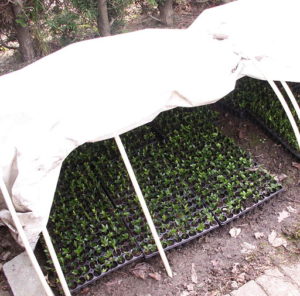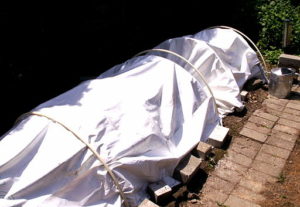

Images attribution: By KVDP (talk).KVDP at en.wikipedia [Public domain], from Wikimedia Commons
A small plastic greenhouse used for cuttings, to keep the cuttings humid while rooting (a prerequisite for the cuttings to catch on). The cuttings are from Buxus sempervirens. (Belgium, 2008)
On Earth, we have developed high-tech and low-tech ways to alter our environment to more successfully grow plants. The above pictures give a low-tech example. But what would be done on MARS to grow plants? Two University of Wisconsin-Stout professors have developed coursework to find out.
Barren of plant life with its dusty, ochre soil, Mars looks like a terrible place to grow food.
Moviegoers this fall have seen it done, however, in “The Martian,” the hit movie about an astronaut stranded on Mars. Actor Matt Damon, as the character Mark Watney, grows food in a covered habitat and, implausibly, survives.
Two University of Wisconsin-Stout professors and their students are proving that it may be possible in real life to grow plants on Mars in a covered habitat like Damon’s.
Associate professors Matt Kuchta, physics, and Mandy Little, biology, are teaching courses in which they examine extreme soil and growing conditions. They’re doing it using their own Martianlike “Hab,” or habitat.
They collected 400 pounds of glacial till subsoil from Chippewa County and, in batches, cooked it at 1,000 degrees for three hours to decompose all organic material. The lifeless soil turned reddish-orange in color and was dry and dusty, similar to the soil on Mars.
Chippewa County soil was used because it has some properties similar to Martian soil, including iron oxide, similar minerals and texture. “It’s as close as we can get (to Martian soil) in the Midwest,” Kuchta said.Student Molly Beaghan waters the plants in the In Kuchta’s dirt lab in Jarvis Hall Science Wing, they’re putting the cooked west-central Wisconsin soil to the test. With various trays under a tabletop plastic dome, they are trying to grow potatoes and other plants in the unfertile soil. Little’s students are doing the same thing in another habitat, the campus greenhouse.
“‘The Martian’ is an excellent way to get students to think about soil as more than just dirt,” Kuchta said. “Sometimes the best way to learn how something works is to take it apart. What better way to learn about the importance of soil organic matter than to remove it entirely and observe what happens?”
A Martian garden
Like in “The Martian,” the professors and students are succeeding. They’re successfully growing alfalfa sprouts, grasses, beans and potatoes.
Read the original article, see images here.
To see what Martial soil actually looks like, visit the next page.



